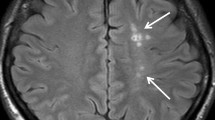Abstract
Purpose
Excluding aplasia and hypoplasia of the P1 segment of the posterior cerebral artery (PCA), anatomical variations in the PCA are rare. To our best knowledge, there are few reports of an extremely long P1 segment of the PCA.
Methods
Herein, we report a rare case of an extremely long P1 segment of the PCA, which was diagnosed by 1.5-T magnetic resonance angiography (MRA).
Results
A 96-year-old woman was transferred by ambulance to our hospital with impaired consciousness. Her symptom improved, and magnetic resonance imaging showed no significant findings. MRA revealed an extremely long P1 segment of the left PCA. The length of the P1 segment of the left PCA was 27.3 mm. The left posterior communicating artery (PCoA) was 20.9 mm, which is not considered long. The left anterior choroidal artery branched from the internal carotid artery distal to the PCoA branching position. Basilar artery fenestration was also incidentally identified.
Conclusion
Careful imaging assessment was important for identifying the extremely long P1 segment of the PCA in the present case. This rare anatomical variation can also be confirmed by 1.5-T MRA.

Similar content being viewed by others
Data availability
All data generated or analysed during this study are included in this published article.
Code availability
Not applicable.
Abbreviations
- AChA:
-
Anterior choroidal artery
- MRA:
-
Magnetic resonance angiography
- PCA:
-
Posterior cerebral artery
- PCoA:
-
Posterior communicating artery
References
Endo H, Ono H, Nakamura H (2023) Complete duplication of the posterior cerebral artery. Surg Radiol Anat 45:359–361. https://doi.org/10.1007/s00276-023-03095-x
Matsuda M, Uchino A, Saito N, Neki H, Kohyama S, Yamane F (2017) Duplicate origin and extremely long P1 segment of the posterior cerebral artery diagnosed by MR angiography. Surg Radiol Anat 39:699–702. https://doi.org/10.1007/s00276-016-1769-8
Saeki N, Rhoton AL Jr (1977) Microsurgical anatomy of the upper basilar artery and the posterior circle of Willis. J Neurosurg 46:563–578. https://doi.org/10.3171/jns.1977.46.5.0563
Uchino A, Ehara T, Kurita H (2019) Hypoplasia of the internal carotid artery with associated fenestration and extremely long P1 segment of the ipsilateral posterior cerebral artery diagnosed by MR angiography. Surg Radiol Anat 41:707–711. https://doi.org/10.1007/s00276-019-02212-z
Uchino A, Saito N, Takahashi M, Okano N, Tanisaka M (2016) Variations of the posterior cerebral artery diagnosed by MR angiography at 3 tesla. Neuroradiology 58:141–146. https://doi.org/10.1007/s00234-015-1614-5
Uchino A, Suzuki C, Tanaka M (2015) Extremely long posterior communicating artery diagnosed by MR angiography: report of two cases. Surg Radiol Anat 37:565–568. https://doi.org/10.1007/s00276-014-1413-4
Acknowledgements
We are grateful to Yasuhiro Izumi (radiological technologist, Nakamura Memorial Hospital, Sapporo, Hokkaido, Japan) for his excellent work. We also thank Emily Woodhouse, PhD, from Edanz (https://jp.edanz.com/ac) for editing a draft of this manuscript.
Funding
The authors did not receive support from any organization for the submitted work.
Author information
Authors and Affiliations
Contributions
Hideki Endo: protocol/project development, data collection and management, data analysis, manuscript writing/editing. Hidetoshi Ono: project development, data management, data analysis, manuscript editing. Bunsho Asayama: data collection, manuscript editing. Hirohiko Nakamura: data management, manuscript editing.
Corresponding author
Ethics declarations
Conflict of interest
The authors have no relevant financial or non-financial interests to disclose.
Ethical approval
All procedures performed in studies involving human participants were in accordance with the ethical standards of the institutional and/or national research committee and with the 1964 Helsinki Declaration and its later amendments or comparable ethical standards. The study was approved by the Ethics Committee of Nakamura Memorial Hospital (No. 2023021001).
Consent to participate
Informed consent was obtained from the patient.
Consent to publish
The participant has consented to the submission of the case report to the journal.
Additional information
Publisher's Note
Springer Nature remains neutral with regard to jurisdictional claims in published maps and institutional affiliations.
Rights and permissions
Springer Nature or its licensor (e.g. a society or other partner) holds exclusive rights to this article under a publishing agreement with the author(s) or other rightsholder(s); author self-archiving of the accepted manuscript version of this article is solely governed by the terms of such publishing agreement and applicable law.
About this article
Cite this article
Endo, H., Ono, H., Asayama, B. et al. Extremely long posterior cerebral artery P1 segment. Surg Radiol Anat 45, 773–775 (2023). https://doi.org/10.1007/s00276-023-03137-4
Received:
Accepted:
Published:
Issue Date:
DOI: https://doi.org/10.1007/s00276-023-03137-4




